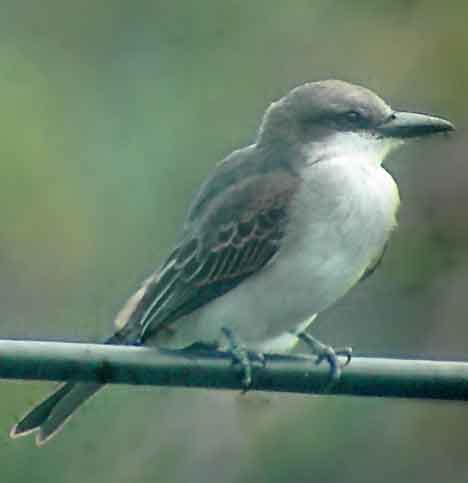
Tyrannus dominicensis (*)
Superregnum: Eukaryota
Regnum: Animalia
Subregnum: Eumetazoa
Cladus: Bilateria
Cladus: Nephrozoa
Superphylum: Deuterostomia
Phylum: Chordata
Cladus: Craniata
Subphylum: Vertebrata
Infraphylum: Gnathostomata
Superclassis: Tetrapoda
Cladus: Reptiliomorpha
Cladus: Amniota
Classis: Reptilia
Cladus: Eureptilia
Cladus: Romeriida
Subclassis: Diapsida
Cladus: Sauria
Infraclassis: Archosauromorpha
Cladus: Crurotarsi
Divisio: Archosauria
Subsectio: Ornithodira
Subtaxon: Dinosauromorpha
Cladus: Dinosauria
Ordo: Saurischia
Cladus: Theropoda
Cladus: Neotheropoda
Infraclassis: Aves
Ordo: Passeriformes
Subordo: Tyranni
Infraordo: Tyrannides
Parvordo: Tyrannida
Familia: Tyrannidae
Subfamilia: Tyranninae
Genus: Tyrannus
Species: Tyrannus dominicensis
Subspecies: T. d. dominicensis – T. d. vorax
Name
Tyrannus dominicensis (Gmelin, 1788)
Synonyms
Lanius dominicensis (protonym)
References
Gmelin, J.F. 1788. Caroli a Linné systema naturae per regna tria naturae, secundum classes, ordines, genera, species, cum characteribus, differentiis, synonymis, locis. Tomus I. Editio decima tertia, aucta, reformata. - pp. i-xii, 1-500. Lipsiae. (Beer). DOI: 10.5962/bhl.title.545 Original description p. 302 BHL Reference page.
Vernacular names
English: Gray Kingbird
español: Tirano dominicano
português: Suiriri-cinza
The gray kingbird or grey kingbird, also known as pitirre, petchary, or white-breasted kingbird (Tyrannus dominicensis) is a passerine bird.
Habitat
This tyrant flycatcher is found in tall trees and shrubs, including the edges of savanna and marshes. It makes a flimsy cup nest in a tree. The female incubates the typical clutch of two cream eggs, which are marked with reddish brown.
Description
The adult gray kingbird is an average-sized kingbird. It measures 23 cm (9.1 in) in length and weighs from 37 to 52 g (1.3 to 1.8 oz).[2] The upperparts are gray, with brownish wings and tail, and the underparts are white with a gray tinge to the chest. The head has a concealed yellow crown stripe, and a dusky mask through the eyes. The dark bill is heavier than that of the related, slightly smaller, tropical kingbird. The sexes are similar, but young birds have rufous edges on the wing coverts, rump and tail.
Call
The call is a loud rolling trill, pipiri pipiri, which is the reason behind many of its local names, like pestigre or pitirre, in the Spanish-speaking Greater Antilles, or petchary in some of the English-speaking zones.
Diet and behaviour
Gray kingbirds wait on an exposed perch high in a tree, occasionally sallying out to feed on insects, their staple diet.
Like other kingbirds, these birds aggressively defend their territory against intruders, including mammals and much larger birds such as caracaras, red-tailed hawks and broad-winged hawks.
Distribution & range
It is found in increasing numbers in the state of Florida, and is more often found inland though it had been previously restricted to the coast. The species was first described on the island of Hispaniola, then called Santo Domingo, thus the dominicensis name. It breeds from the extreme southeast of the United States, mainly in Florida, throughout Puerto Rico, through Central America, through the West Indies, south to Venezuela, Trinidad, Tobago, the Guiana, and Colombia. Northern populations are migratory, wintering on the Caribbean coast of Central America and northern South America. Several vagrant populations are known to exist in the American Northeast.
References
BirdLife International (2016). "Tyrannus dominicensis". IUCN Red List of Threatened Species. 2016: e.T22700509A93781676. doi:10.2305/IUCN.UK.2016-3.RLTS.T22700509A93781676.en. Retrieved 12 November 2021.
Dunning, John B., Jr. (ed.) (1992). CRC Handbook of Avian Body Masses. CRC Press. ISBN 978-0-8493-4258-5.
Hilty, Steven L (2003). Birds of Venezuela. London: Christopher Helm. ISBN 0-7136-6418-5.
ffrench, Richard (1991). A Guide to the Birds of Trinidad and Tobago (2nd ed.). Comstock Publishing. ISBN 0-8014-9792-2.
Retrieved from "http://en.wikipedia.org/"
All text is available under the terms of the GNU Free Documentation License

